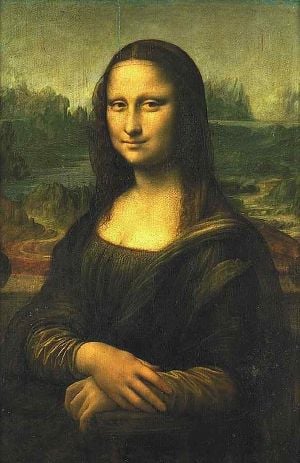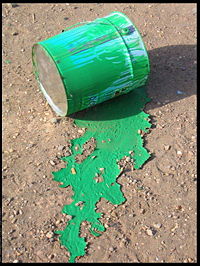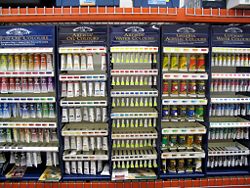Paint
Paint is the general term for a family of products used to protect and add color to an object or surface by covering it with a pigmented coating. Paint can be applied to almost any kind of object. It is used for aesthetic purposes, such as in producing works of art, and for practical purposes, such as in coating and protecting buildings, vehicles, and industrial machinery. Paint is also used to make signs for advertising and directing traffic.
Components
A paint generally has three types of components: a binder, a diluent, and additives. Of these, only the binder is absolutely required. It is the part that eventually solidifies to form the dried paint film. Typical binders include synthetic or natural resins, such as acrylics, polyurethanes, polyesters, melamines, oils, and latex.
The diluent serves to adjust the viscosity of the paint. It is volatile and does not become part of the paint film. Typical diluents include organic solvents such as alcohols, ketones, and esters. Water is also a common diluent. Sometimes volatile synthetic resins also serve as diluents.
Components other than the binder and diluent are called additives. Typical additives include pigments, dyes, catalysts, thickeners, stabilizers, emulsifiers, texturizers, adhesion promoters, and flatteners (de-glossing agents).
After application, the paint solidifies and becomes tack-free. Depending on the type of binder, this hardening may be a result of curing (polymer formation), evaporation, or cooling. The curing process usually involves cross-linking of the molecules of the binder, usually in the presence of a catalyst. Cured-film paints can be either solvent-borne or waterborne.
Some waterborne paints are emulsions of solid binders in water, and they are often referred to simply as "emulsions". When the diluent evaporates, the molecules of the binder coalesce and form polymers, leaving a solid film. Such emulsion paints are also known as latex paints. The polymer itself is not soluble in water, and as a result the paint is water resistant after it has dried.
Some paint films are formed by cooling of the binder. For example, wax paints are liquid when warm and harden upon cooling.
Art
- Main article: Painting

Since the time of the Renaissance, siccative (drying) oil paints (containing primarily linseed oil) have been the most commonly used type of paints in the fine arts. In the twentieth century, however, water-based paints—including watercolors and acrylic paints—became very popular, based on the development of latex and acrylic pigment suspensions. Milk paints (also called casein), in which the medium is derived from milk, were popular in the nineteenth century and are still available today. Egg tempera, in which the medium is an emulsion of egg yolk mixed in oil, is still in use as well, as are wax-based paints. Gouache is a form of watercolor paint that was also used in the Middle Ages and Renaissance for manuscript illumination. The pigment was often made from ground semiprecious stones, such as lapis lazuli, and the binder was made from either gum arabic or egg white. Gouache is commercially available today. Poster paint is usually used for artwork by children.
Pigment
A pigment is a dry colorant, usually an insoluble powder, used in the coloring of paint, ink, plastic, fabric, and other material. When added to paint, it provides color and makes the paint opaque, thus protecting the painted object from the harmful effects of ultraviolet light while also hiding defects on the object's surface. Pigments can be organic or inorganic, obtained from natural products or prepared by chemical synthesis.
When visible light shines on a pigment, the pigment selectively absorbs some colors (wavelengths) of the light whilst reflecting others. The color of the pigment is the combination of colors (wavelengths) that are reflected.
Some pigments are toxic, such as those used in lead paint. For this reason, paint manufacturers have replaced lead white with a less toxic substitute called titanium white (titanium dioxide). This substitute, first used in paints in the nineteenth century, can even be used to color food. The titanium white used in most paints today is often coated with silicon or aluminum oxides for better durability.
Some newer paints, called prism paints, can produce effects where the color appears to change, depending on the angle (orientation) from which it is viewed. These effects can be seen in modern U.S. and Canadian banknotes, specifically the newer, higher denomination notes.
Application
Paint can be applied as a solid, a gaseous suspension or a liquid. Techniques vary depending on the practical or artistic results desired.
As a solid (usually in industrial and automotive applications), the paint is applied as a very fine powder, then baked at high temperature. This melts the powder and causes it to adhere (stick) to the surface. The reasons for doing this involve the chemistries of the paint, the surface itself, and perhaps even the chemistry of the substrate (the overall object being painted).
As a gas or as a gaseous suspension, the paint is suspended in solid or liquid form in a gas that is sprayed on an object. The paint sticks to the object. The reasons for doing this include:
- the application mechanism is air and thus no solid object ever touches the object being painted;
- the distribution of the paint is very uniform so there are no sharp lines
- it is possible to deliver very small amounts of paint or to paint very slowly;
- a chemical (typically a solvent) can sprayed along with the paint to dissolve together both the delivered paint and the chemicals on the surface of the object being painted;
- some chemical reactions in paint involve the orientation of the paint molecules.
In the liquid application, paint can be applied by direct application using brushes, paint rollers, blades, other instruments, or body parts. Examples of body parts include fingerpainting, where the paint is applied by hand, whole-body painting (popular in the 1960s avant-garde movement), and cave painting, in which a pigment (usually finely-ground charcoal) is held in the mouth and spat at a wall (Note: some paints are toxic and might cause death or permanent injury).
Rollers generally have a handle that allows for different lengths of poles which can be attached to allow for painting at different heights. Generally, roller application takes two coats for even color. A roller with a thicker nap is used to apply paint on uneven surfaces. Edges are often finished with an angled brush.
After liquid paint is applied, there is an interval during which it can be blended with additional painted regions (at the "wet edge") called "open time." The open time of an emulsion paint can be extended by adding white spirit, similar glycols such as Dowanol™ (propylene glycol ether) or commercial open time prolongers. This can also facilitate the mixing of different wet paint layers for aesthetic effect.
Paint may also be applied by flipping or spraying the paint, dripping, or by dipping an object in paint.
Product Variants
- Wood stain is a type of paint that is very "thin," that is, low in viscosity, and formulated so that the pigment penetrates the surface rather than remaining in a film on top of the surface. Stain is predominantly pigment or dye and solvent with little binder, designed primarily to add color without providing a surface coating.
- Varnish and shellac provide a protective coating without changing the color. They are paints without pigment.
- Lacquer is usually a fast-drying solvent-based paint or varnish that produces an especially hard, durable finish.
- An enamel paint is a paint that dries to an especially hard, usually glossy, finish. Enamel can be made by adding varnish to oil-based paint.
- Fingerpaint
- Inks are similar to paints, except they are typically made using dyes exclusively (no pigments), and are designed so as not to leave a thick film of binder.
- Titanium dioxide is extensively used for both house paint and artist's paint, because it is permanent and has good covering power. Titanium oxide pigment accounts for the largest use of the element. Titanium paint is an excellent reflector of infrared, and is extensively used in solar observatories where heat causes poor seeing conditions.
- Anti-climb paint is a non-drying paint that appears normal whilst being extremely slippery. It is usually used on drainpipes and ledges to deter burglars and vandals from climbing them, and is found in many public places. When a person attempts to climb objects coated with the paint, it rubs off onto the climber, as well as making it hard for them to climb.
History
Ancient painted walls, to be seen at Dendera, Egypt, although exposed for many ages to the open air, still possess a perfect brilliancy of color, as vivid as when painted, perhaps 2000 years ago. The Egyptians mixed their colors with some gummy substance, and applied them detached from each other without any blending or mixture. They appeared to have used six colors: white, black, blue, red, yellow, and green. They first covered the field entirely with white, upon which they traced the design in black, leaving out the lights of the ground color. They used minium for red, and generally of a dark tinge.
Pliny mentions some painted ceilings in his day in the town of Ardea, which had been executed at a date prior to the foundation of Rome. He expresses great surprise and admiration at their freshness, after the lapse of so many centuries.
- See also lacquer, varnish, fresco
Biological & organic pigments
- Heme/porphyrin-based: chlorophyll, bilirubin, hemocyanin, hemoglobin, myoglobin
- Light-emitting: luciferin
- Lipochromes:
- Carotenoids: alpha and beta carotene, anthocyanin, lycopene, rhodopsin
- Xanthophylls: canthaxanthin, zeaxanthin, lutein
- Photosynthetic: chlorophyll, phycobilin
- Organic: Pigment Red 170, phthalocyanine, Phthalo Green, Phthalo Blue,Alizarin, Alizarin Crimson, crimson, Indian Yellow, indigo, quinacridone, Quinacridone Magenta, woad.
- Resin: gamboge
- Polyene enolates: a class of red pigments unique to parrots
- Other: hematochrome, melanin, Phthalocyanine blue, urochrome, Van Dyke brown
Inorganic pigments
- Carbon pigments: bone black (also known as bone char), carbon black, ivory black, vine black, lampblack, Mars black
- Cadmium pigments: cadmium pigments, Cadmium Green, Cadmium Red, Cadmium Yellow, Cadmium Orange
- Iron pigments: Caput Mortuum, Prussian blue, oxide red, red ochre, Sanguine, Venetian red
- Chromium pigments: Chrome Green, chrome yellow
- Cobalt pigments cobalt blue, cerulean blue
- Lead pigments: lead white, Naples yellow, Cremnitz White, Foundation White, red lead
- Copper pigments: Paris Green, verdigris
- Titanium pigments: titanium dioxide, titanium white
- Sulfur pigments: ultramarine, Ultramarine Green Shade, French Ultramarine, vermilion
- Chrome pigments: viridian
- Zinc pigments: zinc white
- Clay earth pigments: sienna, raw sienna, burnt sienna, umber, raw umber, burnt umber, yellow ochre
External links
- History of Paint
- 20 recipes for homemade paint (text)
- Homemade Paint Recipes for Children
- The Quest of Purchasing Oil Paints
- Comparing Commercial Paints FAQ
- For a glossary of terms used in the paint industry go to Oil & Colour Chemists' Association and click on Paintopedia.
- Pigments through the ages
- Earliest evidence of art found
Credits
New World Encyclopedia writers and editors rewrote and completed the Wikipedia article in accordance with New World Encyclopedia standards. This article abides by terms of the Creative Commons CC-by-sa 3.0 License (CC-by-sa), which may be used and disseminated with proper attribution. Credit is due under the terms of this license that can reference both the New World Encyclopedia contributors and the selfless volunteer contributors of the Wikimedia Foundation. To cite this article click here for a list of acceptable citing formats.The history of earlier contributions by wikipedians is accessible to researchers here:
The history of this article since it was imported to New World Encyclopedia:
Note: Some restrictions may apply to use of individual images which are separately licensed.

